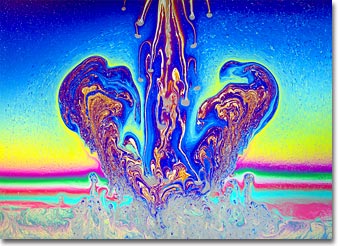Karl E. Deckart
Soap Bubble Gallery: Image Fourteen
German photographer and artist Karl E. Deckart is known for his thorough, precise, and beautiful work both in photography through the microscope and with macro camera systems. This gallery of interference photographs made with soap films is a testament to both Deckart's skill as a photographer and his understanding of the physical phenomena that surround our everyday lives. Presented below is soap bubble image number fourteen in small format. Click on the image to download a larger version.

|
Macrophotography of thin soap films freely suspended on a 4 x 4-inch wire frame was conducted with a Linhof large-format bellows camera system utilizing 4 x 5-inch sheet film and imaged using an apo-macro Nikon large format Nikkor-AM ED 210 mm f-5.6 lens. To prepare the soap film, equal parts of water, glycerin, and dishwasher detergent are thoroughly mixed in a container until a solution containing evenly sized micelles is achieved. A freestanding film is formed by dipping the wire frame into the solution and withdrawing carefully to maintain an even film thickness and avoid disruption of material flow across the frame rails. After suspension, the film was illuminated by a reflected light source positioned a few degrees from the camera system. The light was passed through a diffusion screen to avoid bright spots and provide an even illumination across the field. No polarizers were employed in photomacrography of soap thin films. Image ©1999 by Karl E. Deckart. All rights reserved. |
Surfactants are important components in soap that help remove grease and dirt by reducing surface tension to make water, in effect: "wetter." Water drops that can assume a smaller volume are able to spread more evenly and penetrate nooks and crannies in fabrics and along surfaces, allowing soap to better adhere to and dissolve greasy substances. These surface-active agents have molecular structures that are designed to embed grease particles in a micelle structure that is surrounded by water. The hydrophobic long-chain "tails" of fatty acids and lipids in soaps serve to sequester grease and oil into a region devoid of water molecules. The fatty acid "heads" contain ionized carboxylic acid moieties that hydrogen bond to water to "solubilize" the clustered grease, allowing it to be rinsed away.
BACK TO THE SOAP BUBBLE GALLERY
